|
1.
CENTRAL/ WEST AFRICA
Prices stabilise but further rises expected
Demand for West African timber products remained firm but prices were stable in late April. Moabi LM was the exception, with prices rising .6 to .260 per m3. India and China remained very active in the market. The continued low log supply from Southeast Asia is giving West African exporters every incentive to push prices steadily higher.
European demand for sawn lumber and processed products has improved, with Italian buyers seeming more optimistic than in previous months. UK importers are more interested in KD stock, buying small volumes often via ferry and truck from Dutch importers. House prices
and new house building in the UK are showing some recovery, giving slight confidence to what was a very sluggish market throughout winter.
Although West African sawnwood prices were stable in late April after gains achieved earlier in the month, the market is active and producers are very firm in their current price offers. As with logs, West African producers are well aware of the rising prices, tight supply and longer lead times for Southeast Asian species, and are certain to press buyers into higher price levels through the second quarter.
Unrest in CAR casts doubt on supply of sapele
There is some nervousness in Central African Republic due to political pressures by insurgents from Sudan, which may affect the timber industry already suffering from long travel distances to export ports and restrictions on truck loading weights. This may affect the supply of higher quality and priced sapele lumber.


Cameroon keeps tight rein on corruption
In Cameroon, the government is now strongly implementing its promised fight against corruption by reportedly taking into custody some senior officials. This is expected to assist in the
implementation of controls on illegal logging and unregistered activities of portable bush-sawmills.
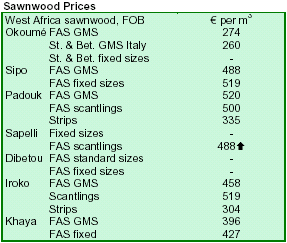
2. GHANA
Ghana maintains GS prices with few exceptions
Ghana¡¯s Forestry Commission (FC) Pricing Committee left largely unaffected the Minimum Guiding Selling Prices (GSP) in the first quarter of 2006 as the variability of market prices was similar to that of the last quarter of 2005. However, there were few exceptions. Prices for niangon boules rose from .460 to .490 per m3 in the quarter under review while those for KD wawa 2C&S (quality two common and select) for Europe rose from .250 to .260 per m3, with few contracts for fixed dimensions achieving .270 per m3. Prices for KD wawa
1C&S remained at $280-$285 per m3 for the Middle East Market, with few contracts at $300 per m3, indicating possible price hikes in the second quarter of the year.
Markets for rotary veneer and plywood in the USA, which were virtually non-existent in the last half of 2005, improved significantly in March 2006. More contracts at improved prices for this market were submitted to the FC for approval. Prices of essa (celtis) rotary veneer core grade with thickness of 4.1/4.2mm and 2.1mm recovered, leading to a GSP of $342 per m3 during the quarter under review. However, there were few contracts made $2-12 per m3 below that level. With few exceptions, most ceiba rotary veneer contracts achieved the GSP. A large
contract was approved by the FC for Messrs Fortuna (Gh) Ltd. to export gmelina billets to India. The agreed price of $110 per m3 was close to the price for gmelina lumber, pushing its price upwards. A volume of 0.152 m3 of coconut lumber with dimension of 85mm x 85mm x 2.10m was exported to Japan on trial basis by Dupaul Wood Treatment Ltd. at .1,040 per m3.
This is the first time this species has been exported.
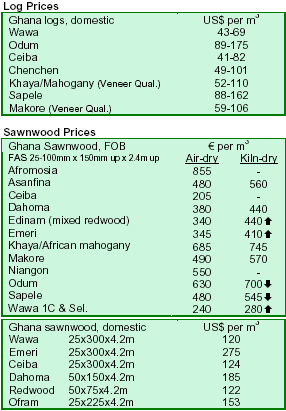
3.
MALAYSIA
Furniture manufacturers turn attention to durian
The buzzword in the Malaysian timber market in recent months is the durian tree (Durio zibethinus). With rubber latex prices soaring to a 20-year high in recent months, the supply situation of rubberwood has reached a critical stage, cornering the Malaysian furniture industry.
While the supply of rubberwood is tight, some buyers think there is some price speculation exacerbating the already difficult situation. This has the undesirable effect of pushing prices for almost every species of timber up across the board, even for those remotely associated with furniture making. Current market rubber prices for SMR20 grade stand at $1.90-$2 and are considered on the high side. A sustainable price for producers and users
alike is between $1.40-$1.50, according to Malaysia's Plantation Industries and Commodities Minister, Datuk Peter Chin Fah Kui.
Fortunately for the local timber industry, the federal government has pledged not to raise fuel prices again this year. Dr. Abdul Rasip Abdul Ghani of the Forestry Research Institute of Malaysia (FRIM) indicated that the local wood-based industry, especially the furniture
industry, is expected to face a grave supply crisis in 15-20 years time, if the depletion of forestry resources is not addressed quickly. He added that based on a study by FRIM, existing 375,000 hectares of various tree species required by the furniture industry would only last about 15 years.
There were at least 2,000 furniture manufacturers in Peninsular Malaysia in 2004. A short-term measure to address the current tight raw material supply situation is to import timber from Vietnam and Thailand. Malaysian manufacturers are already importing timber from
Myanmar and Siberia. Sourcing alternative raw material from Nordic countries, Canada and New Zealand is not presently feasible due to the high freight and shipping charges.
Thus, attention is turning towards the durian tree, more well-known for its pungent fruits than its timber. Durio zibethinus is a very large tree growing up from 25 metres to 50 metres in height. It is of easy workability and its uses include furniture, plywood and veneer. Durian is also found in the wild as well as in plantations in many parts of Peninsular Malaysia. Thailand, however, is the largest durian growing nation in Southeast Asia.
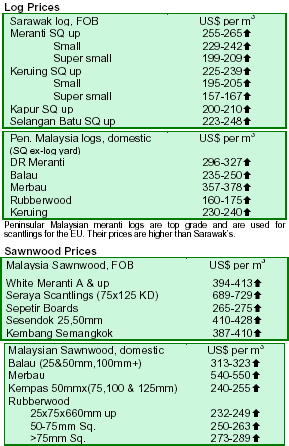
4.
INDONESIA
President calls for intensified efforts against illegal
logging
Indonesian President Susilo Bambang Yudhoyono has called for efforts to save the country¡¯s forests, environment and natural resources immediately and without delay as deforestation in Indonesia has reached an alarming stage. The call was made during Hasanuddin University¡¯s Green Community as part of the commemoration of Earth Day in Tamalanrea.
The President said that about 59 million hectares of forests in the country had been damaged and the condition might get worse as the annual rate of forests damaged by illegal logging reached 2 million hectares, thereby harming the flora and fauna ecosystems. The forest damages, he said, would not only accelerate the extinction of endemic flora and fauna species, but also trigger some catastrophes including floods, landslides, lack of clean water, climate change and forest fires that send smoke to neighbouring states every year.
He proposed to intensify efforts in the fight against illegal logging activities, illegal trading of illegal timber abroad and other activities damaging the forests. The President also launched a nation-wide greening campaign titled "Indonesia Menanam" (Indonesia Plants). He called on governors, district chiefs and mayors to grow forests within cities.
China plans billion dollar merbau plant in Papua
A Chinese company is seeking Indonesia¡¯s approval to set up a timber processing factory worth $1 billion in Papua province, the Minister of Forestry M.S. Kaban announced. The plant would process the province's famous merbau (intsia spp) timber, which would then be
exported to China for the construction of sports facilities for the 2008 Olympic Games. Mr. Kaban said that China needs 800,000 m3 of merbau for the Games.
The company would process all the logs in Papua and then ship them to China as processed timber, mostly as hardwood flooring. Mr. Kaban said that if the planned investment is approved by all parties, the company would be required to implement sustainable forestry
management measures and establish its own timber plantations. He was confident that that the large investment would mean a long-term presence of the Chinese company in Indonesia.
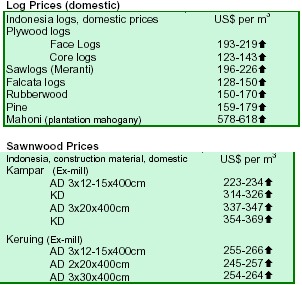
5.
MYANMAR
Teak log demand stays firm despite quiet market
April is normally a quiet month in terms of new sales, as it is the beginning of the new financial year. However, teak logs remained in good demand and prices held firm. Fresh gurjan (keruing) logs coming out from the forests continued to be sold without much difficulty, but remained dependent on the availability of keruing from Malaysia and Indonesia. Nevertheless, the sealed tender average price in April was not promising as it was lower than that in March.

Hoppus ton=1.8m3; All
grades, except SG-3, assorted and domestic, are length 8¡¯ x girth
5¡¯ and up. SG-3 is girth 4¡¯ and up while assorted and domestic are girth
4¡¯ and up. SG-3 grade is higher than
SG-4 but with lower girth and price.

Prices
differ due to quality or girth at the time of the transaction.
6. PAPUA
NEW GUINEA

7.
BRAZIL
Marginal fall in domestic prices
Domestic prices for timber products fell by an average 0.6% in April in spite of a further strengthening of the Brazilian currency. The decline was due to lower exports as Brazilian products continue to lose international competitiveness.
Exports of solid wood products slump in March
Exports of Brazilian solid wood products fell 2.2% to $347.9 in March 2006, compared with the same month in 2005 in line with export declines in most products. Exports of pine sawnwood dropped 18.7% to $26.2 million (down 25.3% to 127,300 m3) while those of tropical sawnwood contracted 10.5% to $45.4 million (down 22.3% to 131.000 m3) in March 2006.
Pine plywood exports also fell 4.4% to 181,800 m3 but declined only marginally (-0.2%) in value to $48.5 million. Tropical plywood showed the largest decline in exports in the period. Export of tropical plywood dropped 44% to $18.1 million (down 53% to 40,600 m3). Furniture exports fell 6.9% to $69.4 million in March
ABIMCI reduces export estimate for 2006
The Brazilian lumber industry is reducing production in 2006 due to the unfavourable exchange rate. The sector had exported $3.03 billion in 2005, down from $3.04 million in 2004 due to the sharp appreciation of the real. Brazilian plywood exports fell 15% to 106 million real ($49.76 million) in the first two months of 2006, according to the Secretariat of International Trade (SECEX). The sector had seen its exports contract 12% to $785.7 million in 2005.
A major plywood producer exporting 80% of its production to the USA and Europe has cancelled $5
million of investment in a new production line in Southern Brazil. Another company also cancelled $9.5 million investment in its existing plants this year. In consequence, the Brazilian Association of Mechanically- Processed Wood (ABIMCI) has reduced its estimate of
Brazil¡¯s solid wood products exports in 2006 by 20%.
DOF replaces ATPF for timber transportation
As reported in November 2005 (TTM 10:18), the Ministry of the Environment (ME) announced that the Forest Products Transport Authorization (ATPF) will be substituted by the Forest Origin Document (DOF) from June 2006. The ME has set up a technical committee to follow the evolution of the new document. While the ATPF was in paper and manually filled, the DOF is a
digital document. Producers will be required to provide online information to IBAMA on the transported product including volume, origin, destination and route.
Furniture sector sees more lay-offs
A recent survey on 50 furniture firms revealed a reduction of 20% in jobs in the sector between December 2004 and February 2006. The furniture sector, as well as other economic sectors, has been hit hard by the sharp depreciation of the US dollar, resulting in loss of
competitiveness. The survey also pointed out at more unemployment should the situation persist.
Firms in High Rio Negro Valley, in northern Santa Catarina, Brazil¡¯s largest exporting furniture cluster, are negotiating annual wages with employees. With 47% of the region¡¯s GDP depending directly on the wood industry and at least half of the population employed by
it, the loss of profitability resulting from the unfavourable exchange rate is forcing firms to rethink strategies of costs reduction, including further employment reduction. Cities in the Rio Negro cluster saw 1,200 lay-offs in 2005 and 500 more in the first quarter of 2006. In addition to lay-offs, firms have reduced wages and working hours to mitigate the
problems caused by the weak dollar.
Funds earmarked for SFM
Over $33.8 million of FNO (Constitutional Financing Fund for Northern Brazil) and Pronaf (Family Agriculture National Program) are available this year through the Bank of Amazonia (BASA) for sustainable forest management (SFM) activities. The amount is part of the projected $2.9 billion being made available for all kind of businesses in the Amazon region.
Credit System, a financing institution of forest activities in the country. Propflora (Commercial Plantation and Forest Recovery Program) is another institution supporting the establishment and maintenance of forests for industrial use and the recovery and the maintenance of preservation areas and legal reserves.
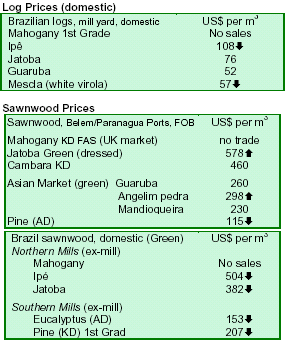
8. PERU
Sawmills mull raising prices to cover energy costs
Sawmills in some timber producing zones are considering to raise prices of wood products in view of higher fuel costs and growing demand for some tropical timber species such as cumaru (Coumaruna odorata), masaranduba (Manilkara bidentata) and tornillo (Cedrelinga catenaeformis).
Pucallpa producers indicated that gasoline and diesel
prices had increased by 4.7% in the first quarter of 2006,pushing up energy costs as electricity is generated by diesel engines. Some producers anticipate that timber prices could increase by up to 35% at sawmill yards. Current board feet prices are at $0.60 for tornillo and $0.48 for cumaru and masaranduba.
INRENA seizes illegal products worth $1.41 million
In the first quarter of 2006, INRENA seized 9,570 m3 of timber and non-wooden products worth $1.41 million. Out of this total, 7,033 m3 were logs and 2,516 m3 were sawnwood. Ucayali (5,106 m3), Loreto (1,877 m3) and Madre de Dios (866 m3) were the regions with the largest
seized volumes. Other regions included Cuzco, Amazonas, Puno, Lambayeque, Tumbes and Piura.
Spanish cedar (2,270 m3 worth $384,474) and mahogany (611 m3 worth $623,589) were the main species seized. Other species included tornillo (1,251 m3 worth $114,880), lupuna (1,777 m3 worth $53,129) and pumaquiro (232 m3 worth $38,037). In addition, 324,235 kg of charcoal and 197 fire logs were confiscated.
The operations involved the collaboration of several institutions, including the National Police Force, the Attorney General¡¯s Office and the Navy. One of the operations revealed a new illegal traffic route in the boundaries of Madre de Dios and Bolivia.
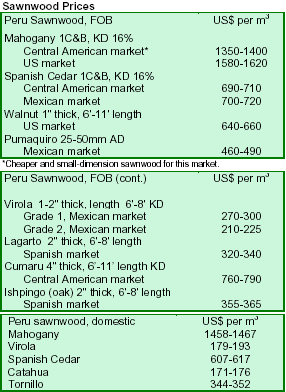
9. BOLIVIA
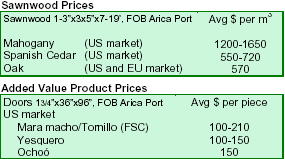
10. Guatemala

11.
Guyana
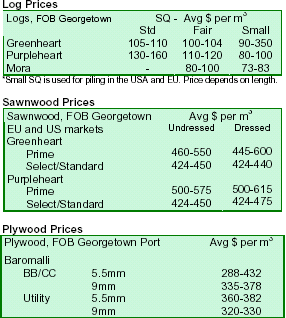
|